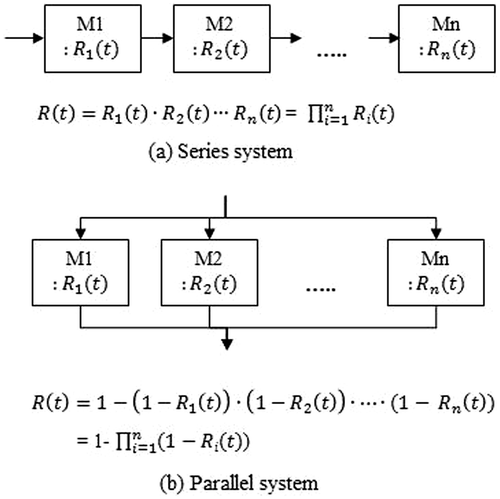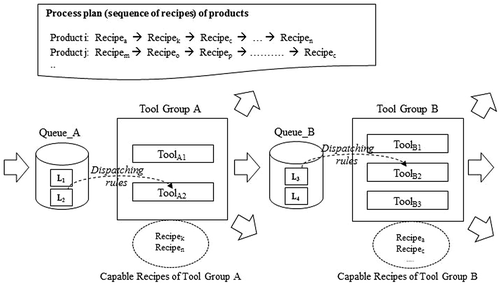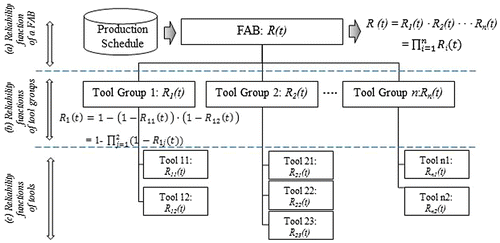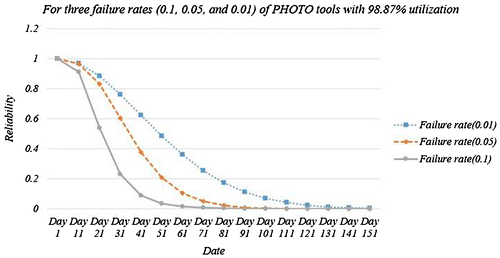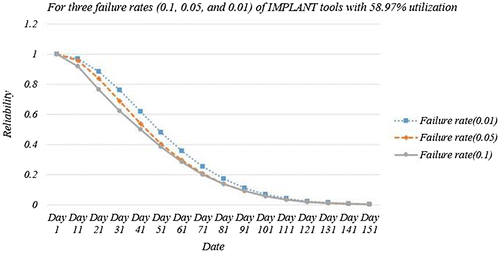 ?Mathematical formulae have been encoded as MathML and are displayed in this HTML version using MathJax in order to improve their display. Uncheck the box to turn MathJax off. This feature requires Javascript. Click on a formula to zoom.
?Mathematical formulae have been encoded as MathML and are displayed in this HTML version using MathJax in order to improve their display. Uncheck the box to turn MathJax off. This feature requires Javascript. Click on a formula to zoom.Abstract
Proposed in this paper is a new reliability model for a wafer fabrication plant (FAB). The reliability prediction of a FAB is essential for various activities; feasibility evaluation, comparing competing designs, identifying potential reliability problems, planning maintenance and logistic support strategies, and input to other studies such as life-cycle cost analysis or order selection. The conventional reliability model, however, is not appropriate for a FAB because of inherent attributes of the manufacturing system; concurrent production of various products, reentrant material flows, and the recipe arrangement problem. To overcome this problem, this paper proposes a new reliability model of a FAB consisting of three reliability functions; reliability function of an entire FAB, reliability functions of tool groups, and reliability functions of FAB tools. To demonstrate the proposed reliability model, a simulation model is constructed based on a wafer FAB data-set. The simulation experiments are carried out with commercial software MOZART®.
Public Interest Statement
To be a successful wafer fabrication plant (FAB) manufacturer, it is necessary to achieve the high utilization and just-in-time production for on-time delivery with minimum work-in-process. Because of this reason, most of previous research results on FABs are focusing on KPIs such as the utilization or the percentage of on-time delivery. It is, however, necessary to observe that all these KPIs assumes a “reliable FAB”, which has to work at or above the minimum acceptable level of reliability. This paper proposes a new reliability model for a FAB, and it has a hierarchy consisting of three steps; reliability function of an entire FAB, reliability functions of tool groups, and reliability functions of FAB tools. To demonstrate the proposed reliability model, a simulation model is constructed based on a wafer FAB data-set, and simulation experiments are carried out with a commercial software system.
1. Introduction
Semiconductor chips play vital roles in almost all electronic products. Today’s chip manufacturing environment is a consumer driven world, and can be described as strong competition, short product life cycle and increased complexity of products and processes. As a result, the chip manufacturing industry faces new challenges each year. The most important thing for a chip manufacturer, however, is always the same which is the creation of higher profit. To increase the profitability, chip manufacturers need to focus on not only a good product but also an efficient manufacturing system which is able to respond to shifts in the global markets by delivering new, high quality products at low costs in a short span of time (Chung, Kim, Seo, & Park, Citation2014; Chung, Lee, & Park, Citation2016; Sarin, Varadarajan, & Wang, Citation2011).
The manufacturing of a semiconductor chip is performed through a sequence of photolithographic and chemical processing steps, during which electrical circuits are gradually created on a wafer made of the pure semiconducting material, silicon. A typical chip manufacturing system, referred as a fabrication plant (FAB), produces a large number of product types and variants concurrently. Production in a FAB is considered as one of the most complicated manufacturing processes because of hundreds of steps (recipes) for a product, re-entrant flows, batch processing, queue time limit, recipe arrangement, and sensitive yield rates of tools (Park et al., Citation2013; Seo, Chung, & Park, Citation2015).
Since the competitiveness of a FAB comes from the high utilization and just-in-time production for on-time delivery with minimum work-in-process (WIP), most of previous research results on FABs are focusing on key performance indicators (KPIs) such as the utilization or the percentage of on-time delivery (Chen, Chen, Lin, & Rau, Citation2005; Li, Tang, & Collins, Citation1996; Zhou & Rose, Citation2010). It is, however, necessary to observe that all these KPIs assumes a ‘reliable FAB’, which has to work at or above the minimum acceptable level of reliability. As depicted by Bowles (Bowles, Citation1992), reliability predictions are essential for various activities: (1) feasibility evaluation, (2) comparing competing designs, (3) identifying potential reliability problems, (4) planning maintenance and logistic support strategies, and (5) input to other studies such as life-cycle cost analysis or order selection. Although, the reliability prediction of a FAB has various applications, it has rarely been brought into focus.
The objective of this paper is to develop a new methodology for the reliability prediction of a FAB. To do so, it is very important to observe the inherent attributes of a FAB which include complicated processes, reentrant flows, and sensitive yield rates of tools. Originally, the reliability engineering started with electronic tubes produced in 1950s (Kao, Citation1956). At that time, the electronic tubes were very unreliable, and this observation led to the reliability prediction of a system. The first standard procedure for the reliability prediction was MH-217 which was published by the US Navy in 1962. While MH-217 were updated several times, other agencies were developing various reliability prediction models including Bellcore RPP, NTT Procedure, British Telecom HRD4, CNET Procedure, and Siemens Procedure (MIL-HDBK-217F Notice 1, Citation1993; MIL-HDBK-217F Notice 2, Citation1995; MIL-HDBK-338B, Citation2007; Telcordia SR-332 Issue 2, Citation2006).
Although the existing reliability prediction procedures cover a wide range of electronic components, they cannot be applied to a FAB including hundreds of manufacturing facilities. Related research results of reliability engineering can be categorized into two groups: (1) System engineers devoted to the tasks of specifying, allocating, predicting, and demonstrating reliability (Andrews, Poole, & Chen, Citation2013; Habchi & Barthod, Citation2016; Jones & Hayes, Citation1999; Lee, Han, & Kim, Citation2006; Lee & Lee, Citation2008; O’Connor, Head, & Joy, Citation1984; Palo, Citation1983; Pecht, Das, & Ramakrishnan, Citation2002), and (2) Physics-of-failure engineers devoted to identifying & modeling the physical causes of failure (Hall & Strutt, Citation2003; Li, Qin, Huang, Zhang, & Bernstein, Citation2006; Li, Stamoulis, & Hajj, Citation1994; Matic & Sruk, Citation2008; Mortin, Krolewski, & Cushing, Citation1995; Stathis, Citation2001; Young & Christou, Citation1994). In both groups, there have been numerous research results. Most of them, however, are focusing on the reliability of electrical components.
To develop a reliability prediction methodology for a FAB, it is necessary to define the reliability function of a FAB. The reliability function is the most frequently used function in life data analysis and reliability engineering. This function gives the probability of an item operating for a certain amount of time without failure. As such, the reliability function is a function of time, in that every reliability value has an associated time value.
Let T denotes the time to failure of a facility, and f(t) is the probability distribution function of T. At this time, the reliability of the facility at time t can be defined as the probability that the facility fails after time t (t > 0), and the reliability function can be stated as . In reliability engineering, the exponential distribution is popularly used, and this paper also assumes that
, where the parameter
(a failure rate) is such that
is the mean time to failure. Based on these definitions, let’s try to model the reliability of a simple manufacturing system consisting of multiple facilities.
As shown in Figure , the reliability function of a system, containing multiple facilities, can be defined by the combination of the facility reliability functions. A series system, shown in Figure (a), fails if any one of the facilities fails. Figure (b) shows a parallel system, and it is a configuration such that, as long as not all of the facilities fail, the entire manufacturing system works. In a parallel system the total system reliability is higher than the reliability of any single component. The simple reliability model, shown in Figure , however, is not appropriate to represent the reliability of a FAB because of three major attributes of a FAB: (1) concurrent production of various products, (2) reentrant material flows, and (3) the recipe arrangement problem (Lin, Wang, & Kuo, Citation2005; Tung Dang, Citation2013). By considering these inherent attributes of a FAB, it is necessary to develop a new methodology to predict the reliability of a FAB. The conventional reliability model, shown in Figure , is no longer valid for a complex FAB.
This paper has two major objectives: (1) development of a new reliability model for a FAB, and (2) development of the reliability prediction methodology based on the new reliability model. To demonstrate the proposed reliability model, a simulation model is constructed based on a wafer FAB data-set, the MIMAC6 from Measurement and Improvement of Manufacturing Capacities. The simulation experiments are carried out with commercial software MOZART® developed by the VMS solutions (Ko, Kim, & Yoo, Citation2013). The overall structure of the paper is as follows. In Section 2, a new reliability model for a FAB is proposed by considering the inherent attributes of a FAB. Section 3 gives the reliability prediction methodology by using the simulation technique. Finally, concluding remarks are addressed in Section 4.
2. Reliability model for a FAB
To produce semiconductor chips, it is necessary to perform a multiple-step sequence of photolithographic and chemical processing steps on a wafer, during which electrical circuits are gradually created. The entire manufacturing process of chips takes a couple of months, and is performed in a FAB which is a highly capital-intensive production system. Since, the effective scheduling of a FAB has been considered as one of the most important problems, there have been numerous research results on the FAB scheduling (Sarin et al., Citation2011). The reliability of a FAB is also very essential to be a successful manufacturer, however, it has rarely been brought into focus.
As depicted above, the conventional reliability model is not appropriate for a FAB which consists of very expensive facilities, and produces a large number of different product types concurrently, 24 h a day. There are various constraints and re-entrant flows which enable such expensive facilities to be shared by many lots requiring the particular processing operation provided by the facility.
A typical FAB consists of hundreds of tool groups, and each tool group may contain multiple tools (machine devices) capable of assigned steps (processes or recipes). As shown in Figure , each tool group has its own queue, a place for WIP lots to wait when they can’t move on because all tools of the tool group are busy. A FAB produces various products concurrently, and each product has its own route according to its process plan. Whenever a tool becomes available, the tool group needs to determine a lot to be processed next among waiting lots in the queue of the corresponding tool group. Since a tool group is supposed to have homogeneous tools, tools belonging to the same tool group may be assumed to have the same capability in terms of the failure rate and the yield rate. Practically, however, this is not true (Aaron, Krott, & Doxsey, Citation2008). Since FAB tools are extremely sensitive, tools even belonging to the same tool group show different failure rates which are affected by three major factors: (1) the type of product, (2) the type of recipe (process), and (3) the attributes of the machine tool. In other words, the reliability function of a FAB is dependent on the production schedule.
This is why the conventional reliability model, shown in Figure , is not appropriate for a FAB, because the conventional reliability model assumes that each tool has a constant failure rate without respect to the types of products and recipes. To overcome the problem, a new reliability model for a FAB is devised, as shown in Figure . The proposed reliability model of a FAB is defined for a given production plan, and it has a hierarchy consisting of three steps: (1) reliability function of an entire FAB, (2) reliability functions of tool groups, and (3) reliability functions of FAB tools.
Since a FAB can be considered as a series configuration of tool groups, a failure of any tool group results in the failure of the entire system. In other words, all of the units in a series system must succeed for the system to succeed. The reliability function of a FAB is the probability that all of the tool groups in the FAB succeed. As a result, the reliability function of a FAB becomes , where n is the number of tool groups, and Ri(t) is the reliability function of ith tool group. While a FAB is a series configuration of tool groups, a tool group is a parallel configuration of tools because tools belonging to the same tool group are capable of the same set of recipes. Thus, the reliability function of the ith tool group becomes
), where m is the number of tools belonging to the ith tool group and Rij(t) is the reliability function of jth tool. As shown in Figure , the reliability function of the first tool group becomes
), because it is the parallel configuration of two tools.
In this way, it is possible to derive the reliability functions of a FAB and tool groups according to their configuration types. If the sensitive nature of FAB tools is ignored, the failure rate of a tool can be considered to have a constant value without respect to the production schedule. In this case, the reliability function of a tool (jth tool of ith tool group) can be stated as , where
, and the parameter
(a failure rate) is such that
is the mean time to failure.
The sensitivity of FAB tools, however, shows that even homogeneous tools belonging to the same tool group show different failure rates according to the production schedule. This is why the conventional reliability model for a FAB cannot be used, and it is necessary to develop a new methodology to extract the failure rate of a FAB tool by considering the production schedule. The detailed procedure is provided in the next section.
3. Simulation based reliability prediction
As mentioned above, the proposed reliability model of a FAB has a hierarchy, and consists of three reliability functions: (1) reliability function of an entire FAB, (2) reliability functions of tool groups, and (3) reliability functions of FAB tools. In the case of the entire FAB and tool groups, the corresponding reliability functions are explained in previous section. If the reliability function of a FAB tool can be identified, then it is possible perfect the proposed reliability model of a FAB. In the case of the reliability function of a tool, however, it is necessary to consider the inherent attributes of a FAB, because the failure rate of a tool is affected by three factors: (1) the type of product, (2) the type of recipe, and (3) the attributes of the machine tool. As mentioned above, the reliability of a tool is dependent on the production schedule.
Figure shows an example, and it assumes that the total operation time of the FAB is 100 h. According to the given production schedule, the ToolA1 is idle (recipe0) for 30 h, performs recipe1 for 50 h and performs recipe2 for 20 h. Since the failure rate of ToolA1 depends on the type of recipes, ToolA1 has three different failure rates, FA10 (failure rate for recipe0), FA11 (failure rate for recipe1), and FA12 (failure rate for recipe2). This paper assumes that the failure rate for each recipe is known via observations. As shown in Figure , the failure rate of ToolA1 (FA1) becomes the weighted average of three different failure rates, FA10, FA11, and FA12. Once the failure rate FA1 is determined, the reliability function of ToolA1 becomes .
Since the reliability function of a FAB tool depends on a given production schedule, the proposed reliability model of a FAB (shown in Figure ) also depends on the production schedule. This means the reliability of a FAB should be evaluated via a simulation for a given production schedule. From the simulation results, it is possible to identify the failure rate of each FAB tool by computing the weighted average of failure rates for different recipes.
To prove the feasibility of the proposed FAB reliability model, a simulation model is constructed based on a wafer FAB data-set, the MIMAC6 from Measurement and Improvement of Manufacturing Capacities. As shown in Table , the FAB model consists of 93 tool groups, the total number of tools is 230 and produces 9 products that have different processing recipes. The total number of recipes is 2,541, and the average number of recipes for each products is 282. The average raw processing time for a recipe is 4,057 s. Each tool group can have multiple tools, from 2 to 7. A lot consists of 24 wafers, and 2,706 lots are released per year under FAB loading of 100%. The commonly used batching policy is minimum batch size, where the batching machine starts service only when the minimum number of lots is waiting in the queue. It is necessary to refer to the MIMAC Final Report for the explanation details (Fowler & Robinson, Citation1995).
Table 1. Configuration of the FAB simulation model
Since the proposed reliability model depends on a production schedule, it is necessary to have a production schedule to evaluate the reliability of a FAB. To generate a production schedule for the FAB shown in Table , this paper uses a commercial simulation software, MOZART®. The simulation is conducted for a time period of 7 months of real production. The first 2 months constitutes the warm-up period, and this period is not considered for statistics. Table shows the average utilizations of tool groups.
Table 2. Average utilization of tool groups
To analyze the sensitivity of the FAB reliability, this paper sets the failure rates of FAB tools with three different values (0.1, 0.05, and 0.01 failures/day). The FAB reliability is computed every 10 days. As the failure rates of tools are increased, the reliability of the FAB is decreased. In the case of Figure , it applies the three different values to “PHOTO” tools with 98.87% utilization. Figures and shows the sensitivity of the FAB reliability when the three failure rates were applied to “IMPLANT” (“WETETCH”) tools with 58.97% (31.75%) utilization. It is possible to notice that tools with higher utilization have a greater impact on the FAB reliability. To achieve the high reliability of the FAB, it is important to manage the failure rates of tools with higher utilization. The experimental results are obvious, and show that the proposed FAB reliability model meets intuition.
4. Conclusions and discussion
A FAB is a semiconductor fabrication plant where devices such as integrated circuits are manufactured. The central part of a FAB is the clean room containing the steppers for photolithography, etching, cleaning, doping and dicing machines. All these tools are extremely sensitive, precise and expensive. As mentioned earlier, the reliability prediction of a FAB is necessary for various activities: (1) feasibility evaluation, (2) comparing competing designs, (3) identifying potential reliability problems, (4) planning maintenance and logistic support strategies, and (5) input to other studies such as life-cycle cost analysis or order selection.
A FAB can be considered as a composite system consisting of multiple tools (including both of serial and parallel configurations), and one may try to apply the conventional reliability model which was originally developed for electronic components. If the failure rate of a FAB tool is independent from the type of a recipe, then this simple approach can work. FAB tools are very sensitive, and show different failure rates which are affected by three major factors: (1) the type of product, (2) the type of recipe (process), and (3) the attributes of the machine tool. In other words, the reliability function of a FAB is dependent on the production schedule.
To develop the reliability model of a FAB, it is necessary to consider the three major attributes of a FAB: (1) concurrent production of various products, (2) reentrant material flows, and (3) the recipe arrangement problem. By considering these inherent attributes of a FAB, it is necessary to develop a new methodology to predict the reliability of a FAB.
A new reliability model for a FAB is proposed which depends on the production schedule. The proposed reliability model of a FAB is defined for a given production plan, and it has a hierarchy consisting of three steps: (1) reliability function of an entire FAB, (2) reliability functions of tool groups, and (3) reliability functions of FAB tools. To demonstrate the proposed reliability model, a simulation model is constructed based on a wafer FAB data-set, the MIMAC6 from Measurement and Improvement of Manufacturing Capacities. The simulation experiments are carried out with commercial software MOZART® developed by the VMS solutions.
Funding
This work was partially supported by Defense Acquisition Program Administration and Agency for Defense Development (UD150042AD, UD1600BD); ICT R&D program of MSIP/IITP (R-20150505-000691); National Research Foundation (NRF-2015R1A2A2A01005871) by the Ministry of Education, Science and Technology, Korea; and a grant (17CTAP-C129828-01) from the Infrastructure and Transportation Technology Promotion research program funded by the Ministry of Land, Infrastructure and Transport of the Korean government.
Additional information
Notes on contributors
Joong S. Jang
Sang C. Park is a professor in the Department of Industrial Engineering at Ajou University. Before joining Ajou, he worked for Chrysler Corporation developing commercial and in-house CAD/CAM/CAPP software systems. He received his BS, MS and PhD degrees from KAIST in 1994, 1996 and 2000 respectively, all in Industrial Engineering. His research interests include semiconductor wafer FAB scheduling, reliability model development, digital manufacturing system, and discrete event system simulation.
References
- Aaron, H. D., Krott, L. C., & Doxsey, J. C. (2008). Optimizing yield and wafer FAB productivity through yield sensitive dispatch. IEEE Transactions on Semiconductor Manufacturing, 21, 318–321.
- Andrews, J. D., Poole, J., & Chen, W. H. (2013). Fast mission reliability prediction for unmanned aerial vehicles. Reliability Engineering and System Safety, 120, 3–9.10.1016/j.ress.2013.03.002
- Bowles, J. B. (1992). A survey of reliability-prediction procedures for microelectronic devices. IEEE Transactions on Reliability, 41, 2–12.10.1109/24.126662
- Chen, J. C., Chen, C. W., Lin, C. J., & Rau, H. (2005). Capacity planning with capability for multiple semiconductor manufacturing fabs. Computers & Industrial Engineering, 48, 709–732.10.1016/j.cie.2004.12.003
- Chung, Y. H., Kim, B. H., Seo, J. C., & Park, S. C. (2014). Due date control in order-driven fab with high priority orders. In A. Tolk, S. Y. Diallo, I. O. Ryzhov, L. Yilmaz, S. Buckley, & J. A. Miller (Eds.), Proceedings of the 2014 winter simulation conference (pp. 2544–2551). Piscataway, NJ: Institute of Electrical and Electronics Engineers, Inc.10.1109/WSC.2014.7020098
- Chung, Y. H., Lee, S., & Park, S. C. (2016). Dispatching for order-driven FABs with backward pegging. Cogent Engineering, 3, 1–10.
- Fowler, J., & Robinson, J. (1995). Measurement and improvement of manufacturing capacities (MIMAC): Final report (Technical Report 95062861A-TR). Austin, TX: SEMATECH.
- Habchi, G., & Barthod, C. (2016). An overall methodology for reliability prediction of mechatronic systems design with industrial application. Reliability Engineering and System Safety, 155, 236–254.10.1016/j.ress.2016.06.013
- Hall, P. L., & Strutt, J. E. (2003). Probabilistic physics-of-failure models for component reliabilities using Monte Carlo simulation and Weibull analysis: A parametric study. Reliability Engineering & System Safety, 80, 233–242.10.1016/S0951-8320(03)00032-2
- Jones, J., & Hayes, J. (1999). A comparison of electronic-reliability prediction models. IEEE Transactions on Reliability, 48, 127–134.10.1109/24.784270
- Kao, J. H. K. (1956). A new life-quality measure for electron tubes. IRE Transactions on Reliability and Quality Control, 7(1), 1–11.10.1109/IRE-PGRQC.1956.6540697
- Ko, K., Kim, B. H., & Yoo, S. K. (2013). Simulation based planning & scheduling system: MOZART®. In R. Pasupathy, S.-H. Kim, A. Tolk, R. Hill, & M. E. Kuhl (Eds.), Proceedings of the winter simulation conference (pp. 4103–4104). Piscataway, NJ: Institute of Electrical and Electronics Engineers Inc.
- Lee, S. W., Han, S. W., & Kim, W. D. (2006). Reliability evaluation system of electronics components. Key Engineering Materials, 326, 569–572.10.4028/www.scientific.net/KEM.326-328
- Lee, S. W., & Lee, H. K. (2008). Reliability prediction system based on the failure rate model for electronic components. Journal of Mechanical Science and Technology, 22, 957–964.10.1007/s12206-008-0212-4
- Li, P.-C., Stamoulis, G. I., & Hajj, I. N. (1994). iProbe-d: A hot carrier and oxide reliability simulator. International Reliability Physics Symposium, 274–279.
- Li, S., Tang, T., & Collins, D. W. (1996). Minimum inventory variability schedule with applications in semiconductor fabrication. IEEE Transactions on Semiconductor Manufacturing, 9, 1–5.
- Li, X., Qin, J., Huang, B., Zhang, X., & Bernstein, J. B. (2006). SRAM circuit-failure modeling and reliability simulation With SPICE. IEEE Transactions on Device and Materials Reliability, 6, 235–246.10.1109/TDMR.2006.876568
- Lin, J. T., Wang, F. K., & Kuo, P. C. (2005). A parameterized-dispatching rule for a Logic IC sort in a wafer fabrication. Production Planning & Control, 16, 426–436.10.1080/09537280500110623
- Matic, Z., & Sruk, V. (2008). The physics-of-failure approach in reliability engineering. In Proceedings of the ITI 2008 30th International Conference on Information Technology Interfaces (pp. 23–26). Cavtat.
- MIL-HDBK-217F Notice 1. (1993). Reliability prediction of electronic equipment, military handbook. Washington, DC: Department of Defense (US).
- MIL-HDBK-217F Notice 2. (1995). Reliability prediction of electronic equipment, military handbook. Washington, DC: Department of Defense (US).
- MIL-HDBK-338B. (2007). Electronic reliability design handbook, military handbook. Washington, DC: Department of Defense (US).
- Mortin, D. E., Krolewski, J. G., & Cushing, M. J. (1995). Consideration of component failure mechanisms in the reliability assessment of electronic equipment—Addressing the constant failure rate assumption. Proceedings Annual Reliability and Maintainability Symposium (pp. 54–59). Washington DC.
- O’Connor, P., Head, M. G., & Joy, M. (1984). Reliability Prediction for microelectronic systems. Reliability Engineering, 10, 129–140.
- Palo, S. (1983). Reliability prediction of microcircuits. Microelectronics Reliability, 23, 283–294.10.1016/0026-2714(83)90335-9
- Park, S. C., Ahn, E., Chung, Y., Yang, K., Kim, B. H., & Seo, J. C. (2013). Fab simulation with recipe arrangement of tools. In R. Pasupathy, S.-H. Kim, A. Tolk, R. Hill, & M. E. Kuhl (Eds.), Proceedings of the 2013 winter simulation conference (pp. 3840–3849). Piscataway, NJ: Institute of Electrical and Electronics Engineers Inc.10.1109/WSC.2013.6721743
- Pecht, M., Das, D., & Ramakrishnan, A. (2002). The IEEE standards on reliability program and reliability prediction methods for electronic equipment. Microelectronics Reliability, 42, 1259–1266.10.1016/S0026-2714(02)00132-4
- Sarin, S. C., Varadarajan, A., & Wang, L. (2011). A survey of dispatching rules for operational control in wafer fabrication. Production Planning and Control, 22, 4–24.10.1080/09537287.2010.490014
- Seo, J. C., Chung, Y. H., & Park, S. C. (2015). On-time delivery achievement of high priority orders in order-driven fabrications. International Journal of Simulation Modelling, 14, 475–484.10.2507/IJSIMM
- Stathis, J. H. (2001). Physical and predictive models of ultrathin oxide reliability in CMOS devices and circuits. IEEE Transactions on Device and Materials Reliability, 1, 43–59.10.1109/7298.946459
- Telcordia SR-332 Issue 2. (2006). Reliability prediction procedure for electronic equipment. Piscataway, NJ: Telcordia Technologies.
- Tung Dang, T. T. (2013). Combination of dispatching rules and prediction for solving multi-objective scheduling problems. International Journal of Production Research, 51, 5180–5194.10.1080/00207543.2013.793857
- Young, D., & Christou, A. (1994). Failure mechanism models for electromigration. IEEE Transactions on Reliability, 43, 186–192.10.1109/24.294986
- Zhou, Z., & Rose, O. (2010). A composite rule combining due date control and WIP balance in a wafer Fab. In S. Jain, R. R. Creasey, J. Himmelspach, K. P. White, & M. Fu (Eds.), Proceedings of the 2011 winter simulation conference (pp. 2085–2092). Piscataway, NJ: Institute of Electrical and Electronics Engineers Inc.

